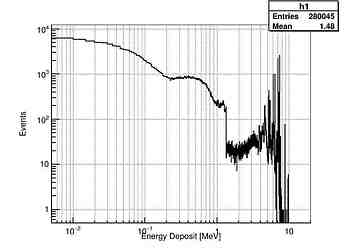Dear Fluka experts,
I’m trying to estimate the energy deposited by a neutron beam with an incident energy of slightly more than 4 MeV traversing 300 - 500 micron silicon target.
Using the score card (for the generalized particle 208) I have studied the distribution of non zero energy deposits in the silicon region but I observe a sharp peak around 190 keV that looks like a lower limit of the energy deposits, since no other deposits appear below this energy. The neutron beam is in the low energy range (below 20 MeV) and I read in the manual that new-defa (or no default) automatically activates low energy transport down to thermal energies, so no special cards as low-neut should be needed, however this does not seem to be the case because if I activate that card the output changes quite a bit. Finally, I have obtained an identical result around 190 keV with the NEUTRONS default.
I went through the documentation and I have seen the PART-THres card and tried to force the low-energy threshold propagation explicitly. No change.
I don’t find any reasonable result even with higher energy neutrons.
Am I missing something?
Thanks in advance,
Micheleneutrons.flair (2.1 KB)
neutrons.inp (1.9 KB)
Dear Michele,
could you upload the user routine you are using as well?
Cheers,
David
Hello David,
you can find it in attach.
Thank you,
Michele
usrmed_liulin_neutroni.f (3.0 KB)
Dear Michele,
what you are witnessing is the effect of the multigroup neutron transport (see section 10.1 of the manual) that applies to all neutrons below 20 MeV.
More specifically, as a result of this treatment, the energy deposition for a neutron of a given group is sampled by means of Kerma factors (see e.g. the comment in 1.1.6) which implies that the values that you obtain in your material are actually discrete. In fact, if you loop through the output files obtained from running your simulation, you will notice that the numerical values of the energy deposited are always fixed, also above the minimum (1.98907306E-04).
This isn’t related to whether the neutrons are or are not transported - in fact, with the settings that you used the transport is activated, as you correctly point out.
Lastly, I wasn’t able to reproduce a different output when using or disabling LOW-NEUT, which is not expected. Could you please share the respective outputs, to better understand what differences you are referring to?
Best
Giuseppe
Dear Giuseppe,
sorry for this late reply. I have carried out several runs and the little differences I have noticed were not related to the 1.98907306E-04 minimum but to the tail of higher energy deposition distribution. The number of events with energy deposited above the minimum was slightly increased with the low-neut card.
By the way, I’m trying to figure out how the energy losses are simulated exactly. We have to compare the simulations with a detector performance and already the input flux is not exactly under control.
Thank you very much for your help.
Dear Giuseppe and Fluka experts,
today I had the chance to compare Fluka and Geant4 results for the same simulation test. I ran first 10^8 neutrons of 1 GeV kinetic energy, and the histograms of the deposited energy in 300 micron silicon slab show an excellent agreement. Unfortunately, it doesn’t appear to be the case at low energies. By considering the same simple geometry the neutron energy was set to 10 MeV. Quite different results were obtained, the two histograms are attached.
I may miss something but I can’t find the problem.
Thanks a lot in advance.
Michele
fluka_n_10MeV.eps (34.2 KB)
LiulinMDU-neutrons.inp (2.2 KB)
LiulinMDU-neutrons.flair (2.5 KB)
usrmed_liulin_neutroni.f (3.0 KB)
Dear Michele,
as mentioned in my post above, FLUKA uses a group-wise treatment for neutrons below 20 MeV, that has the limitation of not yielding a ‘continuous’ event-by-event energy loss distribution, as is particularly evident in the low-E part of the energy loss spectrum. This continuum is instead simulated if you use a point-wise neutron treatment, which is available in Geant4 also below 20 MeV, while in FLUKA v4 below 20 MeV it is only available for few materials (not including Silicon). This explains why the energy deposition spectra look different in Geant4 and FLUKA when the neutron energy is below 20 MeV.
The groupwise treatment of FLUKA is very fast, which is an advantage in many cases (e.g. for shielding studies), but it doesn’t work well in cases like yours where you want to study event-by-event quantities. You can find more details here:
Lastly, the LOW-NEUT card should really have no effect if your target is made of Silicon. To understand the discrepancies that you refer to in your previous post we should look into the full input and output files of the related runs.
Best
Giuseppe
Thank you Giuseppe for your further reply. We wanted to be sure that we were correctly simulating the problem.
The day I posted the first message I was trying several settings in the input file, so I can’t provide the exact output files that shows the discrepancies in the deposited energies. I probably made a mistake because I repeated today the runs with the flair project that was attached to my mail some day ago and the deposited energy histograms are actually identical with and without LOW-NEUT card.
Thank you again for your help,
Michele
